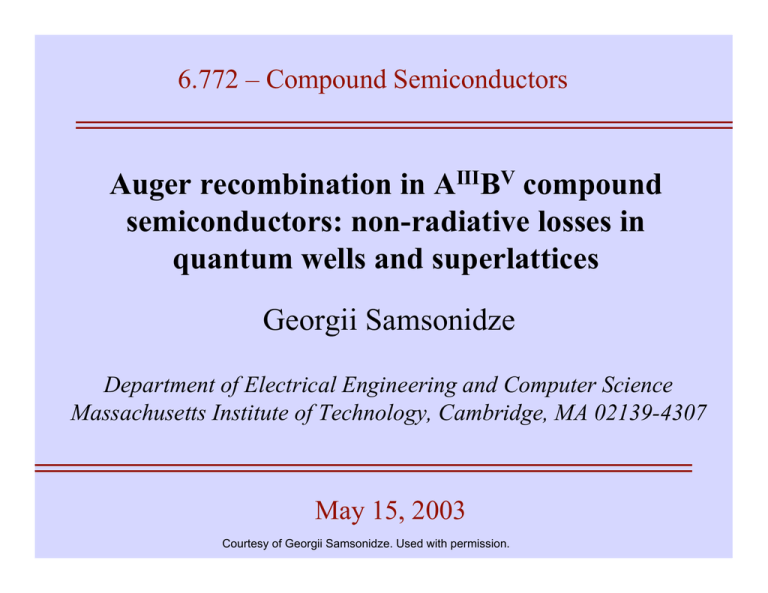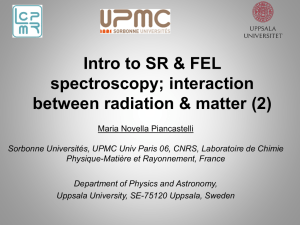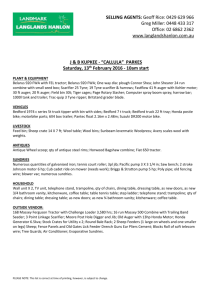Auger recombination in A B compound semiconductors: non-radiative losses in
advertisement

6.772 – Compound Semiconductors Auger recombination in AIIIBV compound semiconductors: non-radiative losses in quantum wells and superlattices Georgii Samsonidze Department of Electrical Engineering and Computer Science Massachusetts Institute of Technology, Cambridge, MA 02139-4307 May 15, 2003 Courtesy of Georgii Samsonidze. Used with permission. Outline v v v v Carrier recombination mechanisms in semiconductors ¸ non-radiative channel: Auger recombination ¸ source of dark current in lasers and detectors ¸ optimized laser structure to reduce Auger Auger recombination enhancement in heterostructures ¸ narrow-gap semiconductor ¸ high doping level ¸ high injection level ¸ wavefunction localization ¸ breaking momentum conservation Theoretical model for direct-gap AIIIBV semiconductors Experimental measurements of lifetime for Auger process Carrier Recombination in Semiconductors v Radiative recombination c recombination rate: Rrad = B(T) n p photon n-type fi lifetime: trad = ( B(T) n0 )-1 phonon electron Rrad = p / trad v direct bandgap: photon hn ª Eg indirect bandgap: photon hn ª Eg + phonon hn << Eg v Non-Radiative recombination ¸ phonon: hn << Eg fi trap-assisted (middle-gap, Shockley-Read-Hall) rate: Rtrap = A(T) p = p / ttrap where ttrap = A(T)-1 ¸ electron: Auger recombination rate: RAuger = C(T) n2 p = p / tAuger where tAuger = ( C(T) n02 )-1 V. N. Abakumov, V. I. Perel, and I. N. Yassievich, Nonradiative recombination in semiconductors, vol. 33 of Modern Problems in Condensed Matter Sciences, North-Holland, Amsterdam (1991,1997) Auger Recombination in Semiconductors ttrap-1 = A << tAuger-1 = C n02 << trad-1 = B n0 high doping level fi dominant: radiative + Auger CHCC Auger process energy is transferred to an enectron direct processes el hh el hh lh lh so so CHHS Auger process energy is transferred to a hole enhancement Eg=DSO momentum conservation fi temperature threshold fi photon-assisted V. N. Abakumov, V. I. Perel, and I. N. Yassievich, Nonradiative recombination in semiconductors, vol. 33 of Modern Problems in Condensed Matter Sciences, North-Holland, Amsterdam (1991,1997) Auger Recombination in Heterostructures wavefunction localization within the quantum well fi fi enhancement of coefficients A(↑), B(↑↑), C(↑↑↑) direct Auger process 1) CHCC 2) CHHS phonon-assisted higher-order impurity scattering etc http://www.ioffe.rssi.ru/SVA/NSM/Auger/model.html http://www.wsi.tu-muenchen.de/nextnano3/input_parser/database/Auger-recombination.htm Direct Auger Recombination Mechanism ()()()()()()()() 2Fermigoldenrule:Coulombinteraction:,,Pauliprinciple:,fifififiifWMEE 221212012,121,312,422,411,32 1 4 3 2 Auger coefficient in heterostructures: C = C1 + C2 + C3 C1: electronic scattering on a single heterobarrier C2: Coulomb interaction within the quantum well C3: Auger electron in the bound state (deep QW) quantum well fi momentum non-conservation fi thresholdless A. S. Polkovnikov and G. G. Zegrya, Phys. Rev. B 64, 073205 (2001) ibid, Phys. Rev. B 58, 4039 (1998) Direct Auger Recombination Calculation Auger coefficients ( C1 , C2 , C3 ) different origin fi different dependencies on QW width, temperature, bandgap, barriers (temperature thresholdless ‹ breaking momentum conservation) A. S. Polkovnikov and G. G. Zegrya, Phys. Rev. B 64, 073205 (2001) ibid, Phys. Rev. B 58, 4039 (1998) Phonon-Assisted Auger Recombination Theoretical calculation for n-type InGaAsP lattice matched to InP tAuger=(Cn2)-1 Auger recombination processes: narrow-gap : direct (dominant) wide-gap : phonon-assisted Auger theory: the sensitivity of the calculation to the band model, wavefunctions, and other approximations used fi disagreements… N. K. Dutta and R. J. Nelson, J. Appl. Phys. 85, 74 (1982) M.Takeshima, Phys. Rev. B 23, 6625 (1981) Recombination Lifetime in narrow-gap InGaAs t=[A+Bn+C n2 ]-1 A — trap-assisted B — radiative C — Auger [phonon ] [photon ] [electron] n-type InxGa1-xAs 0.53<x<1 t µ n-x direct: x=1 phon-assist: x=2 second-order: x = 7/3 W. K. Metzger, M. W. Wanlass, R. J. Ellingson, R. K. Ahrenkiel, and J. J. Carapella, Appl. Phys. Lett. 79, 3272 (2001) Auger lifetime in GaInAsSb/GaSb compounds Auger coefficient increases with decreasing band-gap Auger coefficient increases when Eg=DSO (CHHS process) as observed experimentally M. Muñoz, K. Wei, F. H. Pollak, J. L. Freeouf, C. A. Wang, and C. W. Charache, J. Appl. Phys. 87, 1780 (2000) Carrier lifetime is measured by the standard small-signal optical response technique J. M. Pikal, C. S. Menoni, H. Temkin, P. Thiagarajan, G. Y. Robinson, Rev. Sci. Instrum. 69, 4247 (1998) I. Riech, M. L. Gomez-Herrera, P. Díaz, J. G. Mendoza-Alvarez, J. L. Herrera-Pérez, E. Marín, Appl. Phys. Lett. 79, 964 (2001) and references therein Temperature Dependence of Recombination InAsP/InGaAsP multiple QW laser with band-gap wavelengths — 1.15 mm (shallow gap) — 1.06 mm (deep gap) t = [ A + B n + C n2 ]-1 Nearly 50% of threshold current is due to Auger at room temperature enhancement x100 J. M. Pikal, C. S. Menoni, P. Thiagarajan, G. Y. Robinson, and H. Temkin, Appl. Phys. Lett. 76, 2659 (2000) Narrow-gap InAs/GaSb/AlSb Superlattices R = A + B n + C n2 Experimental (solid diamonds) and computed (hollow squares) total recombination rates per electron-hole pair for the four systems. The dashed lines are fits of the experimental data to the equation shown above. optimal lasing density for structures (a)–(c) is close to 1018 cm-3 and C n2 > 10 ¥ A for these densities the structure (d) is optimized for Auger suppression (sensitive to layer thicknesses fi errors in growth & band model) C. H. Grein, M. E. Flatté, J. T. Olesberg, S. A. Anson, L. Zhang, T. F. Boggess, J. Appl. Phys. 92, 7311 (2002) Summary v Theoretical modeling of Auger recombination ¸ ¸ v Experimental measurements of Auger coefficient ¸ ¸ v contradictory results from different groups very sensitive to band structure models confirms many theoretical predictions increase in QWs of narrow-gap materials Optimize long-wavelength lasers and detectors to minimize Auger recombination (reduce threshold and dark current)




